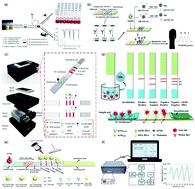Our official English website, www.x-mol.net, welcomes your
feedback! (Note: you will need to create a separate account there.)
Multiplexed detection of biomarkers in lateral-flow immunoassays
Analyst ( IF 3.6 ) Pub Date : 2020-03-03 , DOI: 10.1039/c9an02485a Lei Huang 1, 2, 3, 4 , Shulin Tian 1, 2, 3, 4 , Wenhao Zhao 1, 2, 3, 4 , Ke Liu 1, 2, 3, 4 , Xing Ma 5, 6, 7, 8, 9 , Jinhong Guo 2, 3, 4, 10
Analyst ( IF 3.6 ) Pub Date : 2020-03-03 , DOI: 10.1039/c9an02485a Lei Huang 1, 2, 3, 4 , Shulin Tian 1, 2, 3, 4 , Wenhao Zhao 1, 2, 3, 4 , Ke Liu 1, 2, 3, 4 , Xing Ma 5, 6, 7, 8, 9 , Jinhong Guo 2, 3, 4, 10
Affiliation

|
Multiplexed detection of biomarkers, i.e., simultaneous detection of multiple biomarkers in a single assay, is a process of great advantages including enhanced diagnostic precision, improved diagnostic efficiency, reduced diagnostic cost, and alleviated pain of patients. A typical lateral-flow immunoassay (LFIA) is a widely used paper-based immunochromatographic test strip designed to detect a target biomarker through two common formats: sandwich assay and competitive assay. In order to obtain qualitative or quantitative results, a probe with unique optical or magnetic properties is usually employed to characterize the concentration of the target biomarker. The typical LFIA is suitable for point-of-care testing due to its simplicity, portability, cost-effectiveness, and rapid detection of a target biomarker. However, detection of a single biomarker in the typical LFIA is not favorable for high throughput analysis. Therefore, multiplexed detection of biomarkers in LFIAs has been extensively studied in recent years for high throughput analysis. To accomplish multiplexed detection of biomarkers in LFIAs, the most frequently used structure is a test strip with multiple test lines (TLs), where each TL can detect a specific biomarker. An alternative structure, i.e., a multi-channel structure with multiple test strips, where each test strip has one TL for detecting a specific biomarker, is employed for multiplexed detection of biomarkers. Sometimes, a single test strip with only one TL containing different receptors, where each detection receptor corresponds to a specific biomarker, is another structure applied for multiplexed detection of biomarkers. This paper reviews three common structures for multiplexed detection of biomarkers in LFIAs, i.e., a test strip with multiple TLs, a multi-channel structure with multiple test strips, and a test strip with a single TL. Based on the three common structures, different signal detection strategies that include colorimetric detection, fluorescence detection, surface-enhanced Raman scattering detection, and magnetic detection, along with performance and perspectives are discussed.
中文翻译:

侧流免疫测定中生物标志物的多重检测
生物标志物的多重检测,即在单个测定中同时检测多种生物标志物的过程具有很大的优势,包括提高诊断精度,提高诊断效率,降低诊断成本并减轻患者的痛苦。典型的侧向流免疫测定法(LFIA)是一种广泛使用的纸质免疫色谱试纸,旨在通过两种常见格式检测目标生物标志物:三明治测定法和竞争测定法。为了获得定性或定量结果,通常采用具有独特光学或磁性性质的探针来表征靶标生物标志物的浓度。典型的LFIA具有简单,便携,成本效益高和可快速检测目标生物标记物的特点,因此适合即时检验。然而,在典型的LFIA中检测单个生物标记不利于高通量分析。因此,近年来,针对高通量分析,对LFIAs中生物标志物的多重检测进行了广泛的研究。为了完成LFIA中生物标志物的多重检测,最常用的结构是带有多个测试线(TL)的测试条,其中每个TL都可以检测特定的生物标志物。另一种结构即,具有多个测试条的多通道结构,其中每个测试条具有一个用于检测特定生物标志物的TL,用于生物标志物的多重检测。有时,只有一个包含不同受体的TL的单个测试条(其中每个检测受体对应一个特定的生物标志物)是用于生物标志物的多重检测的另一种结构。本文综述了LFIAs中生物标志物多重检测的三种常见结构,即,具有多个TL的测试条,具有多个测试条的多通道结构以及具有单个TL的测试条。基于这三种常见的结构,讨论了不同的信号检测策略,包括比色检测,荧光检测,表面增强拉曼散射检测和磁检测,以及性能和前景。
更新日期:2020-04-24
中文翻译:

侧流免疫测定中生物标志物的多重检测
生物标志物的多重检测,即在单个测定中同时检测多种生物标志物的过程具有很大的优势,包括提高诊断精度,提高诊断效率,降低诊断成本并减轻患者的痛苦。典型的侧向流免疫测定法(LFIA)是一种广泛使用的纸质免疫色谱试纸,旨在通过两种常见格式检测目标生物标志物:三明治测定法和竞争测定法。为了获得定性或定量结果,通常采用具有独特光学或磁性性质的探针来表征靶标生物标志物的浓度。典型的LFIA具有简单,便携,成本效益高和可快速检测目标生物标记物的特点,因此适合即时检验。然而,在典型的LFIA中检测单个生物标记不利于高通量分析。因此,近年来,针对高通量分析,对LFIAs中生物标志物的多重检测进行了广泛的研究。为了完成LFIA中生物标志物的多重检测,最常用的结构是带有多个测试线(TL)的测试条,其中每个TL都可以检测特定的生物标志物。另一种结构即,具有多个测试条的多通道结构,其中每个测试条具有一个用于检测特定生物标志物的TL,用于生物标志物的多重检测。有时,只有一个包含不同受体的TL的单个测试条(其中每个检测受体对应一个特定的生物标志物)是用于生物标志物的多重检测的另一种结构。本文综述了LFIAs中生物标志物多重检测的三种常见结构,即,具有多个TL的测试条,具有多个测试条的多通道结构以及具有单个TL的测试条。基于这三种常见的结构,讨论了不同的信号检测策略,包括比色检测,荧光检测,表面增强拉曼散射检测和磁检测,以及性能和前景。











































 京公网安备 11010802027423号
京公网安备 11010802027423号